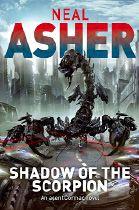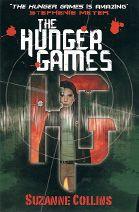Science Fiction: The 101 Best Novels 1985-2010 (49 page)
Read Science Fiction: The 101 Best Novels 1985-2010 Online
Authors: Damien Broderick,Paul di Filippo

Two teens, Jeff Luty and Carlos Tucay, launch a model rocket that kills Carlos, leaving Luty to grow up a heartbroken, embittered and monomaniacal genius. Some years later, Luty runs Nantel labs, with plans to transform the planet Mars into a Dyson sphere of computational self-reproducing nanomachines—
nants
. Working at Nantel is fellow genius Ond Lundquist, who doubts the wisdom of this scheme but goes along with it. Sure enough, after eating Mars the nants turn their omnivorous jaws on Earth. Ond’s autistic son Chu, a math savant, saves the world.
While Luty hides from a vengeful populace behind a quantum mirror, Ond releases orphids: benevolent “smart lice”—intelligent nanoscopic creatures)—to protect against future nant incursions. Linked into a sentient web of global connectivity, or orphidnet, with humanity automatically plugged in, all sights, sounds and knowledge are instantly available to everyone. It’s voyeurs’ heaven, and hell.
Then things really get weird.
The sensory upgrades provided by the orphids reveal the presence of giant, slow-moving Hibraners, intermittent visitors from another dimension. The orphidnet gives birth to beezies, artificial intelligences that culminate in the Big Pig, a Singularity-grade AI. A class of widely despised “kiqqies” arises, using the orphidnet and Big Pig to amplify their intelligence tenfold, but only while they are connected. Vietnamese Thuy and Latino Jayjay, and Big Pig Posse chums lesbian Kittie and code-loving Sonic, are typical dumpster-diving kiqqies. While Thuy endlessly writes her metanovel Wheenk (which just might be the book we’re reading), Jayjay searches for an entry to the Hibrane dimension, and stumbles on teleportation along the way.
But Luty, the Hibraners, and the Big Pig all have competing apocalyptic plans of their own. Humanity is just a trivial bump in the road to be smoothed out—unless Thuy and Jayjay can “unroll the lazy eight,” the compacted eighth dimension of superstring theory hidden in our existing universe:
We use the harp to unroll our
eighth
dimension, which means we make our eighth dimension into an endless line. And—here’s the “lazy” part—we give the line a special metric so that our minds can reach all the way to infinity. Like how the endless decimal 0.9999999... describes a point that’s only one meter away? That’s how the Hibrane already is, if you think about it. Infinity is everywhere. Lazy eight.
Rudy Rucker, as we might predict from his rigorous yet gonzo past work, is one of the few bold visionaries daring enough to envisage a future beyond the veil of a Singularity. He follows unflinchingly what it means for human intelligence to attain new plateaus, inhabiting the twisty minds of those jolted through that phase-state transition without losing our sympathy. He does it by blending eternal human verities—love, lust, greed, incompetence, ambition, jealousy, self-doubt—with new miraculous abilities and powers and potentials.
Two interlocked families—Ond, Nektar and Chu Lundquist, and Craigor, Jil, Momotaro and Bixie Connor—resemble Updike suburban spouse-swappers with same-sex fun thrown in. The Big Pig Posse are recognizable freegan/anarchists whom one might encounter today in their native San Francisco, where much of the novel occurs. So this empathetic characterization supports the scaffolding of mind-boggling postsingular tech that Rucker ingeniously elaborates. Earth undergoes Lazy Eight Day, as compacted dimensions of spacetime unfurl, giving humans godlike powers of telepathy, teleportation and control over sentient matter.
Necessarily, the books are densely written, requiring the reader to participate fully in the intellectual games—
“To travel between the two worlds, a Hibraner turns off self-observation and spreads out into an ambiguous superposed state, and then she observes herself in such a way so as to collapse down into the other brane....
“The encryption lies in the way in which the Hibraner does the self-observation,” said the mushroom. “We can view it as being a quantum-mechanical operator based on a specific numerical pattern. And that would be the encryption code. Think of the code as the orientation of a higher-dimensional vector connecting the branes. It’s a very short distance, but you have to travel in the right direction.”
—yet also captivatingly plotted for sheer narrative verve, laced with humor and suspense. Walking a tightrope between information overload and vivid action, the book captures the zip, zest and buzz of the postsingular milieu, a world where miracles are commonplace, yet structured logically to provide real challenges, risks and triumphs.
Hylozoic
ramps up the strangeness to new levels. Every atom and composite entity now owns at least a rudimentary mind, right up to Gaia, the supreme personification of the whole planet. Humanity consists of post-scarcity slackers and those denialists who stubbornly pursue the old ways of living. Our heroes remain media stars Thuy and Jayjay, now married, and the autistic savant Chu. With a little help from a transdimensional Hieronymus Bosch, these three will combat a dual alien invasion from the Peng and the Hrull, who are intent on colonizing our world.
Rucker’s amiable, antic apocalypse is full of loose-limbed Beatnik/Firesign Theatre/Warner Brothers cartoon goofiness. His rigorous extrapolation of quantum strangeness veers deeply into that territory identified by Arthur C. Clarke, where technology becomes magic, but Rucker plays square with the reader, imposing sharp boundaries of digital logic that encourage genuine narrative peril and suspense. His dialogue-heavy style lends a cinematic immediacy to the action.
Although Rucker’s trilogy begins in the recognizably near future, the whole landscape of Earth, and humanity’s role, is radically transmogrified by this new paradigm of physics. With godlike powers come cosmic-level threats, yet human foibles and virtues naggingly persist. The effect is like an issue of the
Fantastic Four
penned by Freeman Dyson and Edward Witten. What’s most energizing about Rucker’s comic inferno (Kingsley Amis’s phrase for wildly satirical sf) is how precisely it mirrors and valorizes our current condition. As all our revered and immemorial fiscal and cultural systems collapse about us, some of us stick our heads in the sand, but others creatively surf the chaos straight into the optimistic future sf has always held dearest.
92
Neal Asher
(2008)

PART OF THE EXCITING
British Hard Sf/space opera Renaissance of the past two decades, Neal Asher remains perhaps the member of this exclusive club with the lowest profile—at least in the USA, where many of his books have yet to receive secondary publication. This status is undeserved, as Asher’s hard-edged, inventive novels rank as high as those of Alastair Reynolds (Entry 64) or Richard Morgan (Entry 69).
At the time of this writing, twelve of Asher’s novels occupy the common territory of his Polity future history.
Shadow of the Scorpion
is second in the internal chronology, following
Prador Moon,
and hence a good jumping-on point for interested readers. Asher’s main protagonist in the series is secret agent Ian Cormac, deadly employee of the Earth Central Security forces. Published after readers had already become familiar with our hero (starting with
Gridlinked
in 2001), with Asher’s conception of his enterprise now deepened,
Scorpion
jumps back in continuity to explicate Cormac’s youth and his start as an agent, filling in the past of someone we’ve already seen in mature form.
Cormac lives in a period when the galaxy is threaded by the runcible, an instantaneous teleporting device. Naturally, given this instrument, humanity has spread far and wide, aided by artificial intelligences and some other cool tech. Our kind has recently concluded a war against the Prador, a weird and violent arthropoid species. But no member of the Prador is alluded to by the scorpion of the title. That entity is a enigmatic human-created war drone which has been shadowing Cormac for ten years, ever since the death of Cormac’s father when the boy was eight. (One track of the novel follows that youthful Cormac, his mother and his big brother Dax on Earth, in such exotic locales as the undersea city of Tritonia.) The drone seems to bear a message for Cormac, but one which will not be delivered until Cormac has gone through many mortal trials.
The main action of the novel takes place when Cormac is a young adult soldier in the ECS. He and his two mates—Carl Thrace and Yallow N’gar—have just been assigned to the planet Hagren, to guard a crashed Prador warship being plundered by human scientists. The ship also contains awesome weapons, which are desired by the Separatist insurgents. When Carl is proved a traitor and closet Separatist early in the mission, Cormac’s life and future get warped into a mélange of vengeance and patriotism and personal questing for the truth of his own excised past. With his new comrades, including the android Golem Crean, Cormac will learn if he has the right stuff to make an ECS agent.
As the reader might surmise from this précis, Asher’s focus here is on the military side of galactic affairs. And his up-to-the-minute novel proves that every new war ultimately generates its own science fiction, perhaps with some understandable time lag.
WWII and Korea gave us
Starship Troopers
. Vietnam brought us Joe Haldeman’s
The Forever War
(Entry 50). Covert Latin American incursions led to Lucius Shepard’s
Life During Wartime
(Entry 11).And now, in the wake of Iraq I and Iraq II, in a post-9/11, post–Abu Ghraib landscape, we are starting to see a different kind of military sf, most notably in the work of Richard Morgan and a few others, such as Adam Roberts with his
New Model Army
. Granted, there’s still plenty of military sf with its head in the ground, recreating old paradigms with real or false nostalgia. But a few writers with their fingers on the true pulse of events are beginning to depict a future with its roots in contemporary realities. Asher and this novel are part of this phenomenon, by which sf rejuvenates its core concepts.
The way the soldiers of the Polity are rebuilt after what would otherwise be fatal wounds; the way the Separatists wage an insurgency; the way the commanders of the Polity ruthlessly direct their war; the nature of an enemy like the Prador—all these elements and more bespeak close attention to 21st-century headlines. Asher even subtly connects sex and torture, as in the Abu Ghraib scandal. Note the parallel constructions that follow. Here’s Yallow sexily seducing Cormac: “I’m going to need your undivided attention for a good hour.” And here’s ultra-tough Agent Spencer preparing to torture information out of a rebel named Sheen: “You are a very valuable piece of meat and you are going to receive my utter attention over the next few hours.” Case closed.
The result is a rather grim yet compelling depiction of the oddball hells of future wartime, blended with additional characterization and motivation for Cormac. And let us not forget to mention a goodly amount of hip and exciting technological and sociological extrapolation, and many convulsive, propulsive action scenes.
93
Suzanne Collins
trilogy (2008-2010)
